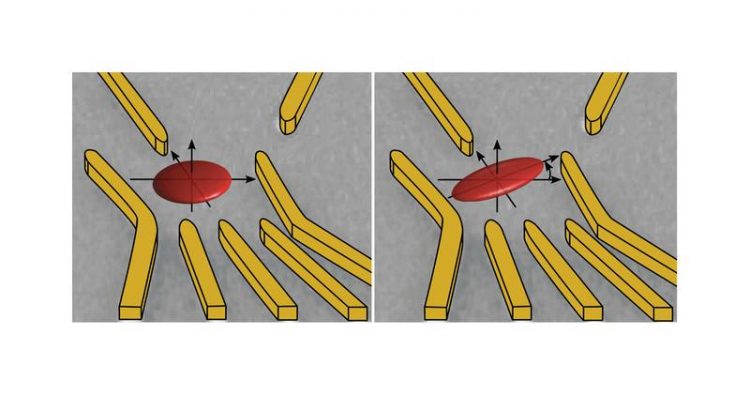The geometry of an electron determined for the first time

An electron in a quantum dot remains, with different probabilities, in certain locations (red ellipses). Using electric fields, the geometry of this wave function can be changed. University of Basel, Departement of Physics
The spin of an electron is a promising candidate for use as the smallest information unit (qubit) of a quantum computer. Controlling and switching this spin or coupling it with other spins is a challenge on which numerous research groups worldwide are working.
The stability of a single spin and the entanglement of various spins depends, among other things, on the geometry of the electrons – which previously had been impossible to determine experimentally.
Only possible in artificial atoms
Scientists in the teams headed by professors Dominik Zumbühl and Daniel Loss from the Department of Physics and the Swiss Nanoscience Institute at the University of Basel have now developed a method by which they can spatially determine the geometry of electrons in quantum dots.
A quantum dot is a potential trap which allows to confine free electrons in an area which is about 1000 times larger than a natural atom. Because the trapped electrons behave similar to electrons bound to an atom, quantum dots are also known as “artificial atoms”.
The electron is held in the quantum dot by electric fields. However, it moves within the space and, with different probabilities corresponding to a wave function, remains in certain locations within its confinement.
Charge distribution sheds light
The scientists use spectroscopic measurements to determine the energy levels in the quantum dot and study the behavior of these levels in magnetic fields of varying strength and orientation. Based on their theoretical model, it is possible to determine the electron’s probability density and thus its wave function with a precision on the sub-nanometer scale.
“To put it simply, we can use this method to show what an electron looks like for the first time,” explains Loss.
Better understanding and optimization
The researchers, who work closely with colleagues in Japan, Slovakia and the US, thus gain a better understanding of the correlation between the geometry of electrons and the electron spin, which should be stable for as long as possible and quickly switchable for use as a qubit.
“We are able to not only map the shape and orientation of the electron, but also control the wave function according to the configuration of the applied electric fields. This gives us the opportunity to optimize control of the spins in a very targeted manner,” says Zumbühl.
The spatial orientation of the electrons also plays a role in the entanglement of several spins. Similarly to the binding of two atoms to a molecule, the wave functions of two electrons must lie on one plane for successful entanglement.
With the aid of the developed method, numerous earlier studies can be better understood and the performance of spin qubits can be further optimized in the future.
Prof. Dr. Dominik Zumbühl, University of Basel, Department of Physics, Tel. +41 61 207 36 93, Email: dominik.zumbuhl@unibas.ch
Leon C. Camenzind, Liuqi Yu, Peter Stano, Jeramy D. Zimmerman, Arthur C. Gossard, Daniel Loss, and Dominik M. Zumbühl
Spectroscopy of quantum dot orbitals with in-plane magnetic fields
Physical Review Letters (2019), doi: 10.1103/PhysRevLett.122.207701
https://doi.org/10.1103/PhysRevLett.122.207701
Peter Stano, Chen-Hsuan Hsu, Leon C. Camenzind, Liuqi Yu, Dominik Zumbühl, and Daniel Loss
Orbital effects of a strong in-plane magnetic field on a gate-defined quantum dot
Physical Review B (2019), doi: 10.1103/PhysRevB.99.085308
https://doi.org/10.1103/PhysRevB.99.085308
Media Contact
More Information:
http://www.unibas.chAll latest news from the category: Physics and Astronomy
This area deals with the fundamental laws and building blocks of nature and how they interact, the properties and the behavior of matter, and research into space and time and their structures.
innovations-report provides in-depth reports and articles on subjects such as astrophysics, laser technologies, nuclear, quantum, particle and solid-state physics, nanotechnologies, planetary research and findings (Mars, Venus) and developments related to the Hubble Telescope.
Newest articles

Recovering phosphorus from sewage sludge ash
Chemical and heat treatment of sewage sludge can recover phosphorus in a process that could help address the problem of diminishing supplies of phosphorus ores. Valuable supplies of phosphorus could…

Efficient, sustainable and cost-effective hybrid energy storage system for modern power grids
EU project HyFlow: Over three years of research, the consortium of the EU project HyFlow has successfully developed a highly efficient, sustainable, and cost-effective hybrid energy storage system (HESS) that…

After 25 years, researchers uncover genetic cause of rare neurological disease
Some families call it a trial of faith. Others just call it a curse. The progressive neurological disease known as spinocerebellar ataxia 4 (SCA4) is a rare condition, but its…





















